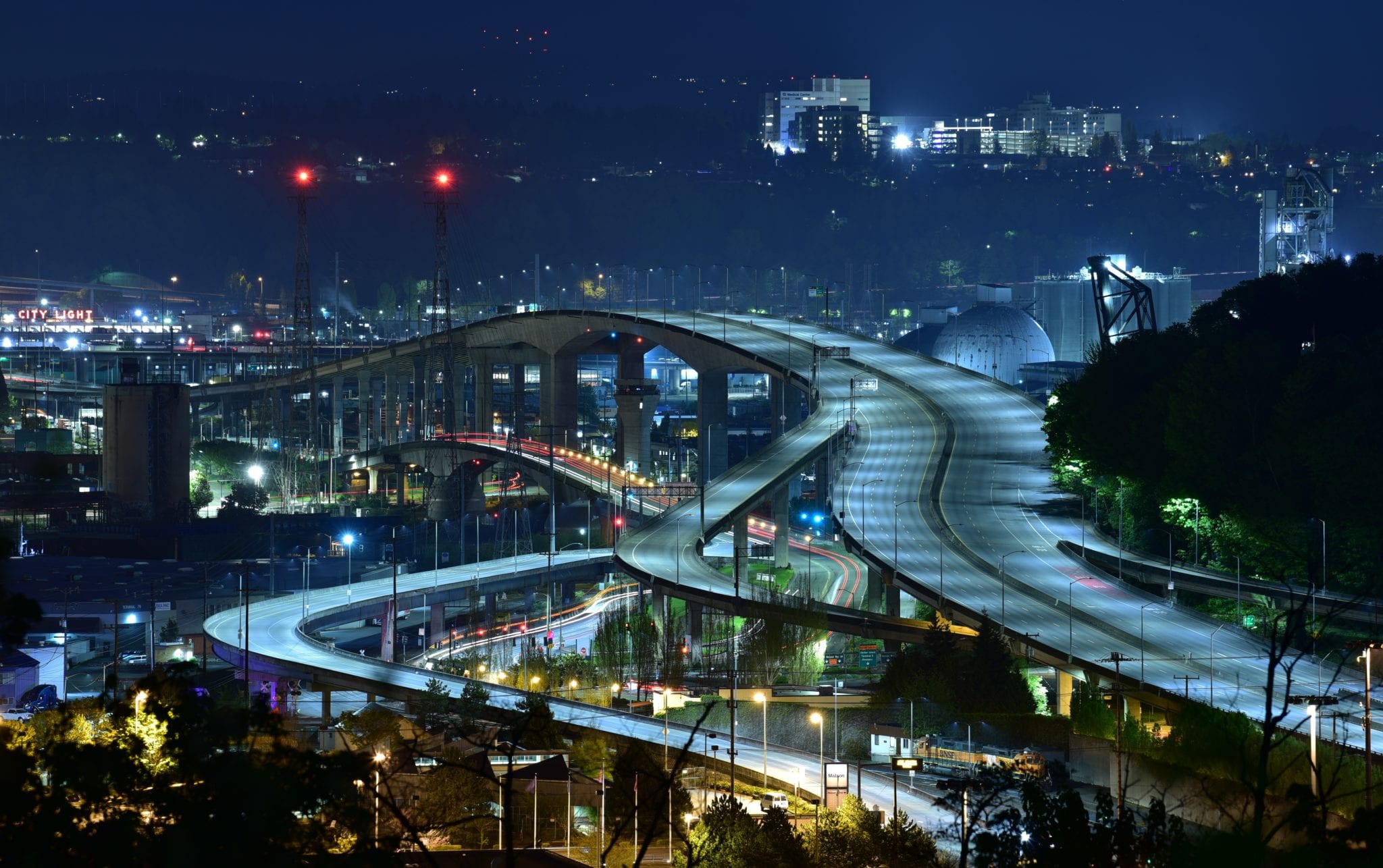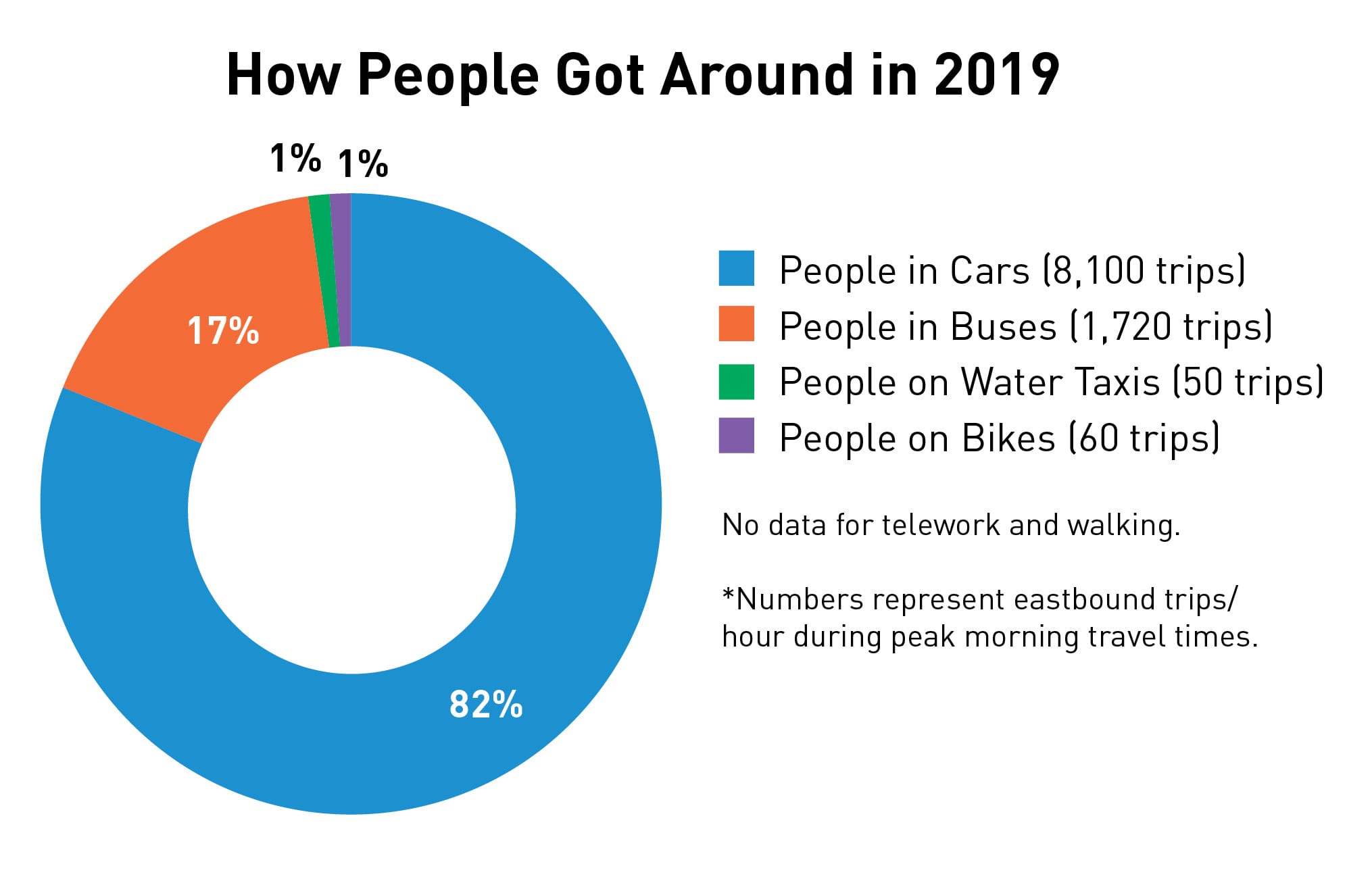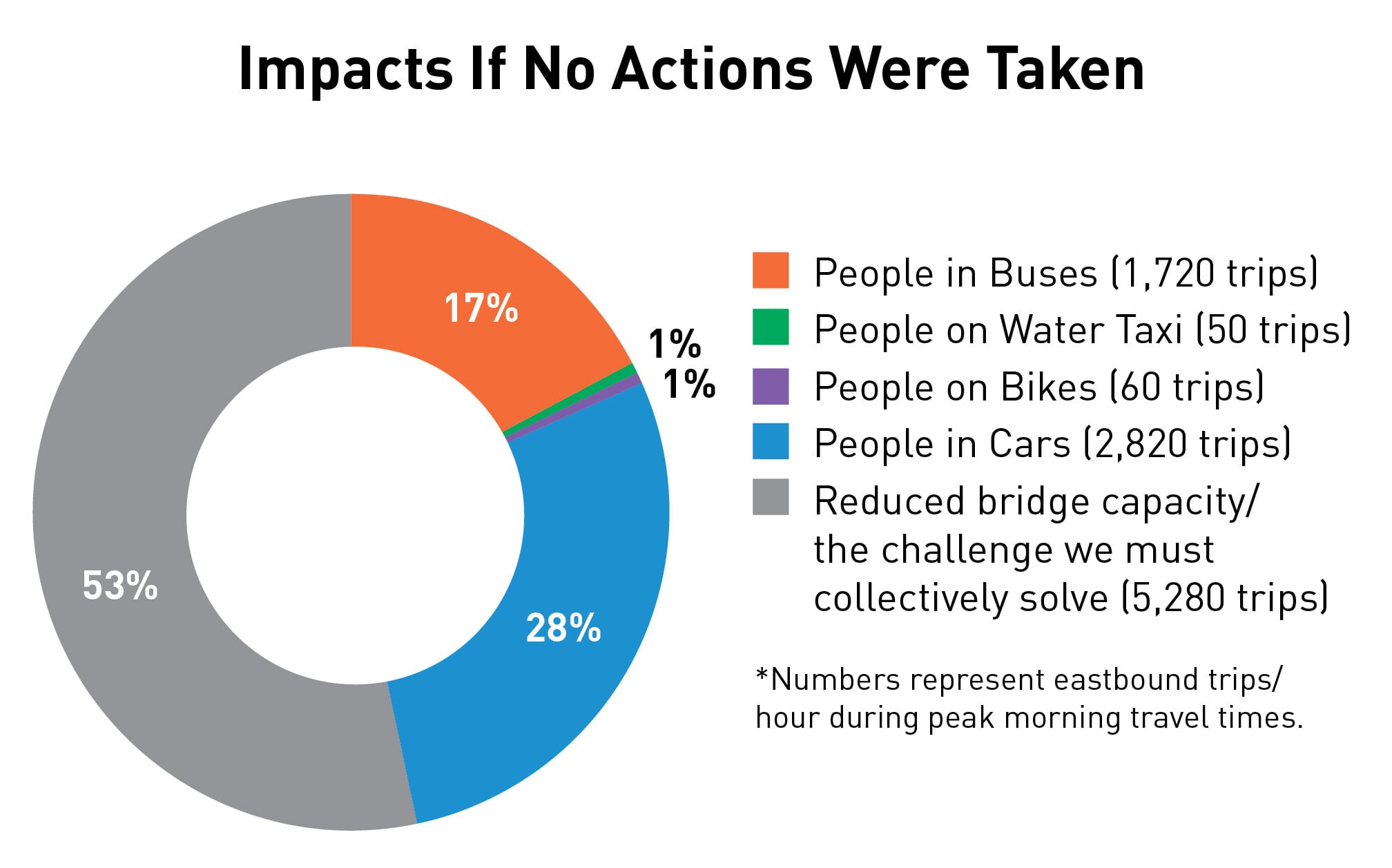 Photo by Chun Kwan.
Photo by Chun Kwan. The West Seattle Bridge Community Task Force held their second meeting today, focusing on one of the most critical issues they will be tackling – traffic mitigation in and around West Seattle.
We are beyond grateful to have this dedicated group of community representatives thoughtfully engage, ask questions, and provide essential feedback as we work to reconnect West Seattle.
Consistent with our commitment to communication and transparency, this meeting was streamed live for public viewing. If you missed it, the recording of the meeting below. In addition, we also wanted to share a brief recap of the discussion.
It is important to note that there are still many important issues for the Community Task Force to consider, such as a potential policy change to allow greater access to the low bridge and a technical update from their peers sitting on the Technical Advisory Panel (TAP). We hope to address both, and more, as soon as next week, on Wednesday, June 24 at 12:00pm, so be sure to mark your calendars!
Today’s meeting started with an update and discussion on the structural health of the West Seattle High-Rise Bridge.
This open-ended discussion gave Community Task Force members an opportunity to revisit the “repair versus replace” decision tree we introduced last week. This conversation also helped illustrate all of the work happening on and off the bridge to gather the critical information needed to make a highly-informed decision about the best path forward.
The primary focus of today’s meeting was about identifying a shared approach for work on the ground and in the community to mitigate the impacts of the High-Rise Bridge closure.
The key takeaway? The challenge is significant, but there is a path forward to reconnect West Seattle while the High-Bridge is repaired or replaced.
The framework for the discussion was a draft proposal called Reconnect West Seattle. Building on the 80+ traffic improvements we have already implemented, we drew on the 30+ town hall and community forums we have attended across the peninsula and surrounding neighborhoods since the closure gathering feedback, to present to the Community Task Force the core challenges we face and a potential approach to restoring similar levels of travel across the Duwamish to those seen before March 23, 2020.
In addition to this peninsula-wide approach, we also introduced a rapid-action, community-led plan to support communities on the south end and Duwamish Valley that are acutely impacted by the increased traffic along detour routes – our Neighborhood Traffic Mitigation Proposals.
We deeply value the questions and input from the Community Task Force. Their feedback will help refine initial concepts, and we expect to roll out our Reconnect West Seattle proposal – and corresponding opportunities for community involvement – in the coming weeks.

The Challenge:
The West Seattle High-Rise Bridge closure has created a traffic management conundrum that can be solved, but will require so much more than traditional detours or service changes.
Intersection, safety, and pavement improvements will be critical to dampen the impacts of the High-Rise Bridge closure, but will only be one small part in a broader effort, that everyone must be a part of, to reconnect West Seattle. The impacts of the COVID-19 pandemic have been a tragic hardship, but one silver lining is an opportunity to scale transportation options and choices in parallel with our phased reopening.
At the beginning of 2020, there were 21 vehicle travel lanes crossing the Duwamish River, with connections to the West Seattle peninsula: the WS bridge (7 lanes), the Low Bridge (2 lanes), the 1st Ave South Bridge (8 lanes) and the South Park Bridge (4 lanes). With the bridge closure and the Low Bridge restrictions, there are now 12 travel lanes for personal vehicles, all concentrated at the south end of West Seattle.

Prior to the High-Rise Bridge closure, there were about 140,000 trips across all four bridges each day. Now, there is only capacity for roughly 52,000 trips each day.
As seen in the graphs above, during peak eastbound morning commute hours in 2019, Car Trips made up about 82% of all trips crossing the Duwamish.
If no actions are taken to help those who are able to adopt alternative modes of transportation but previously drove, there would be a 53% gap once traffic slowly returned to pre-COVID levels. This is the challenge that we must collectively solve to reconnect West Seattle.
Any approach to reconnect West Seattle must be thoughtful in its efforts to address how the closure impacts each community in unique and challenging ways. At the simplest level, the High-Rise Bridge closure creates different challenges for the south end of West Seattle and the Duwamish Valley neighborhoods compared to the north end of West Seattle.
South and West Seattle and the Duwamish Valley communities:
With the closure of the High-Rise Bridge, detour routes off the peninsula lead traffic south. The increased traffic and accompanying air pollution along the detour routes disproportionately impact the south end of West Seattle and Duwamish Valley where communities already face a number of environmental injustices, including:
- Proximity to the Lower Duwamish Waterway Superfund site, one of the most toxic hazardous waste sites in the nation
- Air pollution from a disproportionate number of polluting industries
- Air pollution from surrounding major highways – State Highways 99 and 509, and I-5
Consequently, people in these communities face greater health, public safety, and economic disparities including higher rates of asthma and lower rates for life expectancy. These disparities are only compounded by the High-Rise Bridge closure. The Community Task Force was presented with a framework that aims to mitigate these outsized impacts.
This is also a race and social justice issue as the Duwamish Valley community is far more diverse than much of Seattle. In South Park, 63% of residents are people of color and 40% speak a language other than English at home.
North end of West Seattle:
While the north end of the peninsula has a driving capacity disadvantage today, there are promising water, transit, and bike opportunities.
To address all of these challenges, we developed an initial Reconnect West Seattle proposal that we brought to the Community Task Force today to dissect and strengthen.
Here is our initial Reconnect West Seattle vision:
We envision a reconnected West Seattle peninsula that has similar levels of travel across the Duwamish to those seen before the closure of the High-Rise Bridge, while also reducing the environmental injustices that impact communities in the Duwamish Valley.
We will get there through a community-led process to identify challenges and prioritize solutions – for those who are able – that increase options for transit ridership, bike and pedestrian trips, and safety on our streets and sidewalks, especially in neighborhoods that are acutely impacted by increased traffic.
It is possible to return a similar level of travel across the Duwamish, but to get there, we need to work together to find creative solutions that reconnect West Seattle.
As mentioned earlier, if everyone who traveled by car across the Duwamish followed the same behavior as they did before the bridge closure, then there would be a 53% driver gap. These people need another way to reach their destination. We fully, sincerely acknowledge that it is simply not possible for everyone to make a dramatic shift, so we must work to provide a multitude of options so those who can make a change feel empowered, safe, supported, and resourced to do so.


Today, we shared with the Community Task Force a framework to illustrate one approach to filling that 53% driver gap.
It can be done if systems are in place so people who are able can choose alternatives to driving alone.
We are in this together and we have identified numerous ways to help people use different modes of transportation. The Community Task Force discussion today was not to identify the specific solutions each can bring, but rather to acknowledge the opportunities, constraints, and close partners we have been discussing and meeting with on a daily or weekly basis, and will continue to be a key part of all efforts to reconnect West Seattle.
| Mode | Opportunities | Constraints | Partner |
| Bikes, e-bikes | Quick and reliable; existing infrastructure - can be improved | Not an option for everyone; hills and weather; personal expense for e-bikes | Biking groups; neighborhoods, bikeshare providers |
| Buses | Priority access to the low bridge; fastest route downtown | While social distancing remains, capacity will be limited; Near term funding is constrained | Metro |
| Demand Management | Telework, flexwork/shifting travel time, promotions, encouragement, or incentives for non-SOV travel | Funding, participation, employer needs and policies. Flexwork does not work for all jobs or all trips | Metro, Commute Seattle, employers |
| Ferries | Historic precedent of sending ferries straight from Vashon to Colman Dock | Colman Dock remains under construction, with limited capacity; only 40% of Fauntleroy arrivals go downtown | Washington State Ferries (WSF) |
| Private Sector Shuttles | Compliment transit by adding additional routes and/or capacity; exploring shared options | Security issues around sharing services; coordinating among private entities | Employer resource group meetings – June 23 |
| Vanpool/Carpool | Flexible option for those not well served by transit esp. during social distancing. Apps make matching easy; many employers support vanpool | Social distancing limits interest particularly for starting new groups. Parking at destination varies. | Metro Vanpool, apps like Waze Carpool, Scoop |
| Water Taxis | Good option for people in northern West Seattle. Partnership opportunities | Access and parking are challenges; requires big increase in service beyond Seattle Squeeze levels | Metro, Port of Seattle, private providers |
This approach supports everyone living and working on the peninsula, but we acknowledge that some of these proposed resources, like water taxis, more easily benefit people living on the north end of the peninsula.
In addition to this peninsula wide approach, we also introduced our approach to support communities on the south end and Duwamish Valley that are acutely impacted by the increased traffic along detour routes – our Neighborhood Traffic Mitigation Proposals.
The Community Task Force is central to the Neighborhood Traffic Mitigation Proposals. This process will be community-led and members on the Community Task Force from these neighborhoods have been, and will, play a key role in making sure the voices of their neighborhoods are heard, especially groups that, unfortunately, have not always been part of these conversions.
We used a racial equity lens to prioritize four areas disproportionately impacted by the closure of the West Seattle High-Rise Bridge and corresponding detour route:
- Highland Park, Roxhill, S. Delridge, Riverview
- South Park
- Georgetown
- SODO
Over the past few months, we have listened to community requests and, for each neighborhood, compiled a list of potential projects that will cost less than $100,000 and take under 12 months to complete. In partnership with the Community Task Force and local neighborhood groups, these communities will be asked to prioritize which projects are most needed at this time to improve safety and traffic outcomes in their neighborhood.
Working closely with the Community Task Force, we will review the communities’ priorities, and create implementation plans informed by available funding. We will then go back to the community to review the plan and set a timeline for going forward.
We are grateful for the commitment, passion, expertise, and time of each member of the Community Task Force.
We value their thoughtful feedback on our initial Reconnect West Seattle proposals, and we will take it all into consideration as we finalize the proposals and share them with the community in coming weeks.
The next Community Task Force meeting will be held on June 24 at 12 noon. We will share a link to watch the meeting live when it becomes available.

